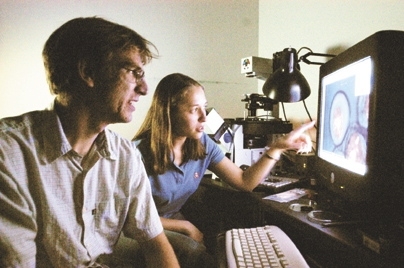Students in MIT's newest Ph.D. program are going where no students have gone before. In September, MIT launched its graduate program in Computational and Systems Biology, the first of its kind in the country.
The first four students matriculated this fall into the interdisciplinary program at the interface of biology, engineering and computer science.
"We get to be the trailblazers," said graduate student Sabrina Spencer, whose impressive credentials include an undergraduate degree from George Washington University, a master's degree in human genetics from the University of Michigan, and extensive work in cancer biology. The other three students are Laura Sontag, who has a degree in mathematics and biomathematics; Alexander Mallet, who has a computer science degree; and Grace Zheng, who holds a degree in biology and computer science.
These graduate students will conduct research under the joint supervision of Computational and Systems Biology Initiative (CSBi) faculty from different disciplines in science and engineering. The plan is for the graduates to use their training in computational modeling and systematic experimentation, and their ability to think both at the molecular and systems levels to tackle challenging problems in complex biological research.
"True progress in understanding complex biological phenomena will require new insights from a systems perspective, using tools and concepts from engineering and computer science," said Bruce Tidor, associate professor of bioengineering and computer science and chair of the CSB Graduate Program Committee.
"To make this come about, we need to build a strong multidisciplinary community at the interface of biology, engineering and computation. We also need to educate a new breed of researchers that will thrive at this interface," said Tidor.
Students will take foundational classes in modern biology, computational biology, experimental approaches and computer algorithms, and perform a literature-based inquiry into the emerging field of computational and systems biology. They also will make rotations in research groups to gain a deeper appreciation for work at the frontier of this field. Core classes will be supplemented by advanced electives in science and engineering to enhance the breadth and the depth of education.
The new approach emphasizes the functional behavior of collections and builds on the more traditional approach of studying the roles of components. As such, the focus moves from individual players to the concerted effect of networks and pathways leading to biological complexity.
"It's like zooming out as opposed to in," explained Spencer. "If you only study biological systems using a reductionist approach and look only at very small pieces of the whole puzzle, you might miss the larger dynamics of what is going on."
The integrative and interdisciplinary nature of the curriculum fits with National Institutes of Health (NIH) educational priorities. The NIH launched a series of new initiatives under the NIH Roadmap aimed at encouraging interdisciplinary research and education, including a five-year, $16 million research grant to CSBi.
This fall, NIH awarded CSBi another grant, a five-year training grant for $3 million to support students in the Ph.D. program, involving Tidor as the principal investigator and 18 other engineering and science faculty who teach core courses in the new program.
Interestingly, many of the faculty had to invent novel programs to train themselves for careers as interdisciplinary researchers. For instance, Amy Keating did undergraduate work in physics, carried out both her Ph.D. and postdoctoral research under the joint supervision of an experimentalist and a theorist, and is now an assistant professor of biology using experiment and theory to study protein-protein interaction networks. Joel Voldman was trained as an electrical engineer but did postdoctoral work at Harvard Medical School in stem cell differentiation to prepare for a career developing new BioMEMS devices to probe cellular function. He is currently an assistant professor in electrical engineering and computer science.
"The CSBi doctoral program continues MIT's long tradition of pioneering graduate education in new interdisciplinary fields," said Provost Robert A. Brown. "CSBi is a critical part of MIT's activities at the interface between biology, engineering, physical science and mathematics."
A version of this article appeared in MIT Tech Talk on October 27, 2004 (download PDF).






